Oak Hill Country Club History
Explore the rich tradition.
With each major championship it proudly hosts, Oak Hill scribes another chapter in golf's memory book.
~ by Sal Maiorana
It certainly wasn't the stuff that picture postcards are made of, but it was a functional, satisfactory piece of property, those 85 acres comfortably nestled next to the Genesee River that served as home to Oak Hill when club was formally incorporated in 1901. The leased land was mostly barren, there were only nine golf holes laid out, and the clubhouse was a converted farmhouse lit by kerosene lamps.
However, for the 137 members who began playing this intriguing sport, which was relatively new in America, it was a haven of social activity and recreation, and it was all theirs.
Over the next 20 years, the members - whose original financial commitment to the club consisted of a $25 initiation fee and yearly dues of $20 - watched with glee as Oak Hill grew to become one of the centerpieces of Rochester, a clear reflection of the prosperity the city was enjoying.
In 1905 the members decided to buy the property at a cost of $34,000; in 1910 another nine holes were constructed; in 1911 a new clubhouse was built; and by the end of World War I, Oak Hill was churning out some of the finest golfers in Western New York, a testament to the increasing maturity and difficulty of the golf course.
With its membership growing, golf gaining rabid popularity, and the course beginning to take on some character through careful landscaping and nurturing, Oak Hill was a club its members - who counted some of the most powerful men in the city's history - were extremely proud of.
Thus, in 1921, when the University of Rochester first proposed a land swap whereby the university would build its new "River" campus on the banks of the Genesee where Oak Hill was situated, with the club being relocated to a 355-acre plot of farm land in the town of Pittsford, the members were understandably skeptical.
However, these men did not achieve their lofty financial, business and community status without being blessed with intelligence, foresight and civic awareness. Though they loved their club, they recognized a golden opportunity that would ultimately benefit Oak Hill, the university and the city.
The university, originally located on Prince Street, was growing in stature, not only locally but nationally and internationally. It needed an expansion, especially after talk that Kodak's George Eastman, the school's most generous and influential patron, was interested in funding the building of a music school and a medical center. By allowing the small arts and sciences college a chance to grow into the prestigious institution it is to day, the quality of life in Rochester would only improve.

Oak Hill Country Club Circa 1901
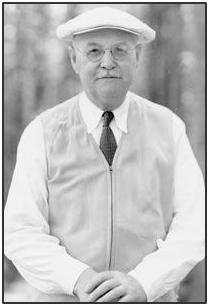
Donald Ross
Architect & Course Designer
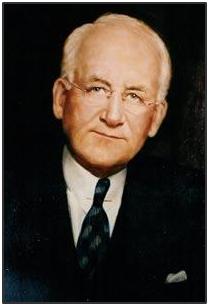
John R. Williams
As for Oak Hill, moving to Pittsford presented an opportunity to start anew, and the club could do so with the university chipping in $360,000 as part of the deal. With its acreage more than quadrupled, there was room for two 18-hole courses that would be designed by world-famous architect, Donald Ross.
Also, a stately Tudor-style clubhouse would be built providing first-class amenities and accommodations for the members, their families and guests. It was a win-win situation, like trading Joe DiMaggio for Ted Williams, and final ratification of the historic agreement came in April, 1924.
The members continued to play on the old course while the Pittsford site was being prepared, and they officially moved to their new home in 1926. It was then that Dr. John R. Williams surveyed the new playground and concluded that Ross' wonderful designs would be enhanced by trees - thousands upon thousands of oaks, maples, evergreens and elms, but of course, mostly oaks.
The majority of the Pittsford land was barren, much the way the original riverside Oak Hill site was in 1901. The soil had been beaten badly by more than 100 years of farming, and there were very few trees, giving the two courses a cheerless look to them. So Dr. Williams, already a leading research physician who had pioneered the use of insulin to treat diabetes, took up botany and horticulture as a hobby aimed at transforming Oak Hill into the landmark it has become.
He once said, "The Almighty was the greatest landscape architect of all. It was his plan to have oaks at Oak Hill." And Dr. Williams implemented that plan. He said he lost count at 75,000, the number of seedlings he planted, and as you walk the grounds of Oak Hill today, you can't help but gaze skyward at the majestic trees that dominate the landscape. They soar to the heavens, lending both an unmatched beauty and a treacherous detriment to one's scorecard.
It boggles the mind to think that nearly all of these wonders began as little acorns - collected from all over the world - in the small backyard garden of Dr. Williams' home at 388 Monroe Avenue.
As the trees began to grow, it became obvious that the combination of Ross' and Williams' skills had created a masterpiece, and the time to put it to the test arrived in 1934. As a dual celebration of Rochester's Centennial and the 20th anniversary of native son, Walter Hagen's first U.S. Open triumph, the Hagen Centennial Open was contested on the East Course, the more demanding of the two courses. Leo Deigel posted a four-round total of 276 and took home the first prize of $600.
Seven years later, the Times-Union newspaper put up a $5,000 purse, and a star-studded field of 138 players came to town, led by Hagen, Sam Snead, Ben Hogan and Gene Sarazen. The tournament belonged to Snead who shot 277 and won by seven over Hogan. Despite the ease of his victory, the course had tested Snead, and he said, "This course is certainly one of the finest I have ever seen, fit for either an Open or a PGA."
Hogan loved the course, too, and he vowed to return in 1942. He did, and he won, shooting a 64 in the first round, which remains the course record.

Sam Snead

Cary Middlecoff

Lee Trevino
By now, Oak Hill was gaining momentum and recognition nationwide, and its reputation as one of the best courses in America was cemented when the USGA decided to hold the 1949 U.S. Amateur there. Charlie Coe of Oklahoma City defeated Rufus King of Texas 11-and-10, and when the event concluded, Joseph Dey, then executive director of the USGA, asked of Oak Hill, "Where have you been for 20 years?"
The USGA returned in 1956 with its biggest tournament, the U.S. Open, and Dr. Cary Middlecoff outlasted Hogan, who missed a 30-inch putt on the 71st hole and ultimately lost by one stroke.
Twelve years hence, the Open was back and Lee Trevino won his first professional tournament, becoming the first man in history to shoot four rounds of sub-70 golf in an Open.
Jack Nicklaus joined the list of Hall of Fame winners on the East Course when he rolled to a record seven-stroke victory in the 1980 PGA Championship. Miller Barber was victorious in the 1984 U.S. Senior Open and Curtis Strange made history when he won the 1989 Open at Oak Hill, becoming the first man to repeat as champion since Hogan put back-to-back victories together in 1950 and 1951.
Six years later, 1995 Ryder Cup was contested over three days on the East Course. It was blessed with yet more dazzling golf and another nerve-jangling finish. It was a tale of more battling comebacks but, unlike at The Belfry two years earlier, this time it was the Europeans who snatched a dramatic victory over the final holes. It was left to Irishman Philip Walton to seal the glory. Three up, with three to play against Jay Haas, Walton lost the next two but amazingly secured victory even with a bogey five on the last. The Ryder Cup trophy returned on the Concorde to Europe.
In 1998, 50 years after its first Amateur, the tournament returned, having not been contested in New York State since it was at Oak Hill in 1949. Hank Kuehne wowed the massive galleries with booming drives and won on the 35th hole over Tom McKnight.
While the professional majors certainly carry honor and prestige, Oak Hill's membership was every bit as excited about playing host to the finest amateur players in the world. After all, tournament chairman and Oak Hill member Bill Westerfeld said, "We are about amateur golf, that's the game that we play, so to have the national championship is really pretty terrific".
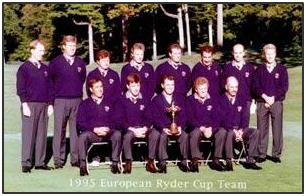
1995 European Ryder Cup Team
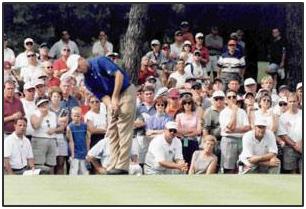
1998 Ryder Cup
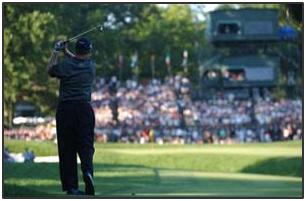
2003 PGA Championship
The 2003 PGA championship featured 100 of the best players in the world. Contested over the pristinely groomed East Course, it provided a challenge that the best golfers in the world could not conquer. Tiger Woods proclaimed the East Course the hardest, fairest golf course the players have ever played and Ernie Ells agreed saying, "It is the best, fairest and toughest championship golf course I've ever played in all my years as a tour professional." Shaun Micheel was the eventual champion and one of only three people to tour all 72 holes under par.
How good is Oak Hill? In the five stroke play championships contested at Oak Hill, only 10 players have been under par. Not too bad for a grand old tract of land that has evolved into one of the golf's hidden gems.
The 2008 Senior PGA Championship was a true test of golf for the world's greatest senior players. Yielding only 12 sub-par rounds over some grueling spring weather, the golf course once again was the champion. However there was another great champion that week in Jay Haas. His 7-over was the highest winning score in relation to par in the 69-year history of Senior PGA, shattering the previous high of 2-over set by Sam Snead in 1970 at PGA National at Palm Beach Gardens, Fla.
Haas entered Sunday at 3 over, tied with Hometown favorite Jeff Sluman and a shot behind Bernard Langer. On Saturday, Haas was five shots off the lead when he carded an eagle-2 on No. 17 by holing a shot from 162 yards to vault into contention. His shot-making wasn't as magical on Sunday, and he particularly struggled with his putter. Haas missed a 3-footer for par on No. 11, and a 12-footer for par on 17. Haas took the outright lead when he holed a 10-foot birdie putt on the par-3 5th. With the rest of the field collapsing behind him, Haas led by as many as three shots, but fell back after missing a 15-foot par putt on 13. Memories flooded back to his final match of the 1995 Ryder Cup matches as he reached the 18th tee.
Oak Hill is no stranger to wild finishes and late-round collapses. This was the place where the European Team rallied from a 2-point deficit on the final day to beat the United States 14-13 in the 1995 Ryder Cup. And Haas played a role in that loss, muffing the 18th hole to lose his singles match to Philip Walton, the decisive point for European victory.
This championship allowed Oak Hill to lay claim that no other golf club in the world can make. It is the only club to have hosted the PGA Championship, the Ryder Cup, the United States Open, the United States Amateur, the United States Senior Open and the Senior PGA Championship! And we did this in only 24 years. Not a bad claim for a golf club in upstate New York!
~ by Sal Maiorana
In keeping with our desire to bring the very best golf competition to the Rochester community, Oak Hill looks forward to hosting more national championships in the future.
This story provided by Sal Maiorana, a sportswriter for the Rochester Democrat and Chronicle. He covers golf, the Buffalo Bills, the Rochester Knighthawks and college lacrosse. He also is the author of three books, including "Through The Green," an inside look at life on the PGA TOUR through the eyes of tour professional Davis Love III.


